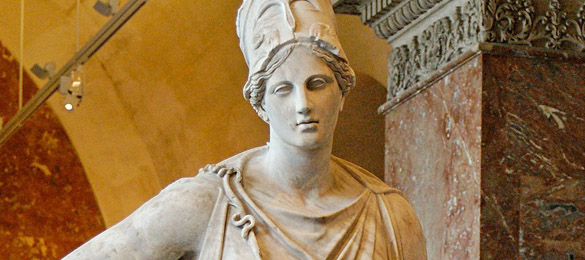Major in Ancient and Medieval Studies

"Mattei Athena,” located in the Louvre Museum; Roman copy of the Greek goddess of wisdom, from 1st century BC/AD, after a 4th century BC Greek original, attributed to Cephisodotos or Euphranor. Photograph by Jastrow (2006); public domain via Wikimedia Commons.
Through a wide variety of subjects drawn from a number of disciplines, this program provides a curricular framework for exploring topics in ancient and medieval studies which range from the history of ideas and institutions to that of material artifacts, literature and certain of the original languages. The chronological span of the program includes some 6,500 years between 5000 B.C. and 1500 A.D.
The goal of this program is to develop knowledge and understanding of the more distant past both for itself, in its uniqueness, and as an object of specifically modern questions and methods of inquiry. We are interested in the structure of institutions and social systems, and in relationships between the social order and learned traditions, values, ideologies and ideas. Ancient and medieval studies derive a special claim to our interest from the fact that the record is so full and multiform and that much of it is of exceptionally high quality at once in substance and form.
The Major in Ancient and Medieval Studies is designed for students who are seeking a fuller understanding of the forces which shaped the ancient and medieval world. The geographical and chronological scope of the program is broadly conceived and is intended to be comparative. Subjects range in content from Classical Greece and Rome, and the ancient societies of Asia and South America, to medieval Europe and Japan. Students will be required to demonstrate intermediate level language proficiency in either Greek, Latin or a medieval vernacular, but they need not concentrate their other subjects on the area associated with that language. Students are also expected to have some distribution across the ancient and medieval time periods. We expect that students will consult closely with the Major Advisor in order to devise a coherent program of study.
As noted in the degree chart, the program includes a minimum of nine subjects (108 units) beyond the pre-thesis tutorial (21.THT) and thesis (21.THU). The nine subjects must include one language subject in Area I (or equivalent proficiency); the eight remaining subjects must be selected from at least two of the three other disciplinary areas (Areas II-IV), with at least one subject in both Ancient and Medieval periods. To satisfy the communication-intensive (CI-M) component of the program, students may select two subjects from among 3.990 Seminar in Archaeological Method and Theory, 21H.331 Julius Caesar and the Fall of the Roman Republic, 21H.240 The World of Charlemagne, 21H.390 Seminar in Historical Methods, or any Literature seminar (21L.700-21L.715) with an ancient or medieval focus.
Area I: Languages
Area II: Arts and Architecture
Area III: Literary Studies
Area IV: Material and Historical Studies
Up to six subjects (72 units) may be used for both the major and the GIRs, but the units from those subjects may not count toward the 180 units required beyond the GIRs. No more than one HASS Distribution class may be counted towards the major and towards the HASS Distribution Component of the GIRs. Of the subjects required for the major, at least eight must count only toward this major (and not toward any other degrees, major or minor).
Click here for the latest listing of eligible subjects.
This list is not exhaustive. Relevant subjects that are no longer offered and subjects with variable topics (such as “special subjects” or “selected topics” courses, for example) may also be counted at the discretion of the major advisor.
Additional information can be obtained from the History Office, E51-255, 617-253-4965,
or by emailing shass-ug@mit.edu.